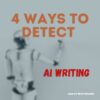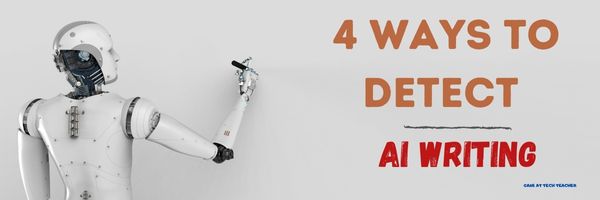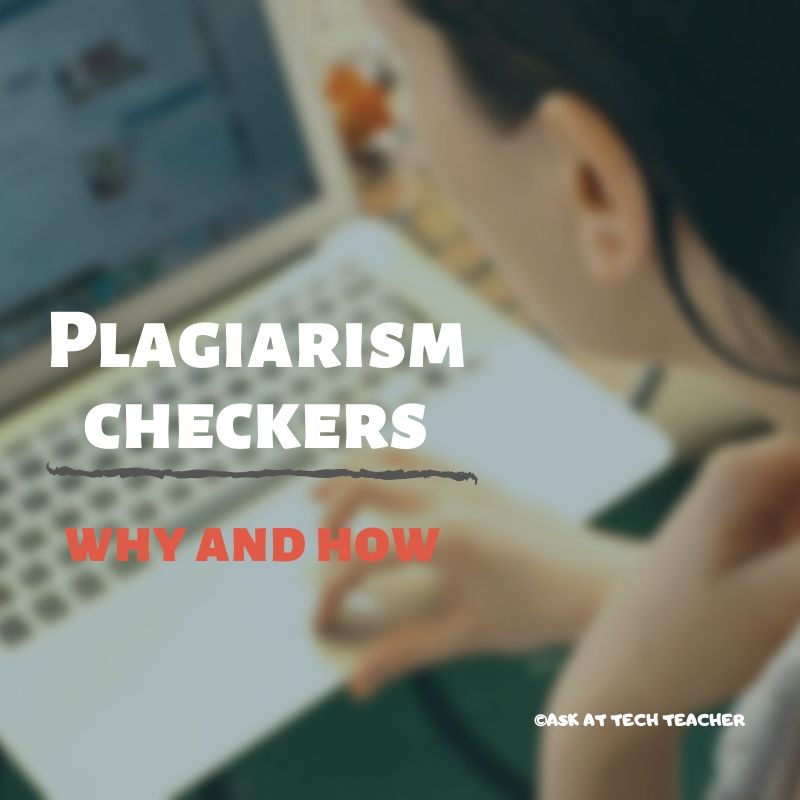Tag: plagiarism
13 AI Detectors and 11 Plagiarism Detectors
Here are popular online resources to teach about AI detection and Plagiarism detection:
AI Detector
Click here for updates to this list:
- AI Content Detector–from Crossplag
- AI Text Classifier–from the creators of ChatGPT to identify writing from an AI
- ChatGPT–has developed their own tool to find AI-generated writing
- Content at Scale AI Content Detector
- Contentdetector.org
- Copyleaks AI Content Detector
- Crossplag–detect AI content
- GPTZero–to find text generated by an AI
- Plagiarismchecker.ai
- TurnItIn ithenticate–new tool to identify AI-generated text
- UNDETECTABLE.AI
- Winston A.I
- ZeroGPT
Finding plagiarism
Share this:
4 Approaches to Detect AI Writing
AI-generated writing, currently centered around ChatGPT, already is a disruptive force in education. Check out these articles:
- How ChatGPT Can Improve Education, Not Threaten it–from Scientific American
- ChatGPT threatens education at all levels – here’s how it can be stopped–from Tech Radar
- ChatGPT: The Next Firestorm in Education–from AACSB
ChatGPT has this to say about itself being a threat to student writing skills:
Detecting AI writing can be a difficult task, as modern AI systems are becoming increasingly sophisticated in their ability to produce human-like text. However, there are a few indicators that can help you identify whether a piece of writing has been generated by an AI system.
-
- Consistency: One of the most noticeable features of AI writing is its consistency. Unlike human writers, AI systems tend to produce text that is consistent in tone, style, and grammar throughout the entire piece.
- Repetition: AI systems often rely on pre-programmed templates and patterns to generate text, which can result in repetitive phrasing and wording.
- Unusual errors: While AI systems are generally quite accurate in their use of grammar and spelling, they can sometimes make unusual errors or produce awkward phrasing that is not typical of human writing.
- Lack of context: AI systems can struggle to understand the broader context of a piece of writing, which can lead to text that is disconnected or irrelevant to the topic at hand.
Pretty good? Or not? The problem is, because it’s not obviously incoherent, how do you tell it was written by an AI? Here’s what Jodi Williams, one of Ask a Tech Teacher’s tech experts suggests to help you decide:
4 Approaches to Detect AI Writing
Sometimes the use of technology can play a bad joke on us, especially when we turn to various AI-based tools that help to write things instead of ourselves. The practice shows that the AI Writing phenomenon contributes a lot to the cases of plagiarism and poses a severe problem for educators as they have to check assignments manually and spend more time evaluating the content. Still, it’s possible to detect the issue even when students use solutions like ChatGPT. The trick is to use analytical tools and evaluate the readability factor!
Share this:
5 Tips to Avoid Plagiarism
Thanks to easy access to internet resources and a serious lack of understanding on the part of many students about what online resources can legally be used, plagiarism has become a huge problem in schools. Students don’t have a clear idea about what media–like images, videos, text–are legal to use and what constitutes proper citations. SEO expert, Tara Troy with Copyleaks, explains where plagiarism often happens and then how to avoid it in your work (and she provides her suggestion for a reliable plagiarism checker):
5 Tips for Students: How to Avoid Plagiarism
 A few well-know issues that diminish the standards of a students’ writing are listed below:
A few well-know issues that diminish the standards of a students’ writing are listed below:
Method of citation: There are different styles for citing references. Students have to follow the method prescribed by the school or University.
Missing references: Making simultaneous notes for references taken down for a paper helps in the last-minute rush of inserting footnotes and/or endnotes in a paper.
Grammatical errors: Software aided checking services are highly useful in detecting and correcting grammar mistakes in an academic paper.
Spelling mistakes: Online spell checker detects spelling errors.
Plagiarism: Stealing information and references without correct citations cause the problem of plagiarism. One needs to check for plagiarism with an online plagiarism checker before submitting the paper. Copyleaks plagiarism checker for students is a free online tool that can be used.
Tips for Students to avoid plagiarism while writing
A few useful actions that help in eradicating plagiarism are discussed below:
- Initiate the research process early:
Writing everything in a rushed manner often leads to plagiarism. Individuals indeed tend to take down the information and paraphrase it for completing the project quickly. Genuine students are committed to their research activity and attempt to produce new knowledge through their research.
Share this:
Plagiarism Checkers: The Benefits Students Fail to See
Ask a Tech Teacher contributor Serhii Tkachecnko, CEO at Unicheck, shares his thoughts on how educators can teach students about the benefits of plagiarism checking.
***
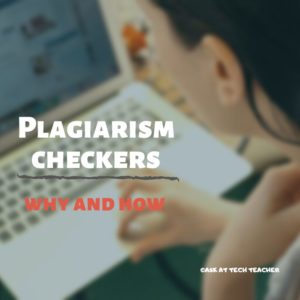 Students experience an array of emotions toward education: from excitement to boredom. But when it comes to plagiarism checking, most students feel hostile. Many misconceptions circle around plagiarism checkers, but in reality, plagiarism checkers improve the cooperation, communication, and collaboration between educators and students. They are meant to help students and educators succeed.
Students experience an array of emotions toward education: from excitement to boredom. But when it comes to plagiarism checking, most students feel hostile. Many misconceptions circle around plagiarism checkers, but in reality, plagiarism checkers improve the cooperation, communication, and collaboration between educators and students. They are meant to help students and educators succeed.
Instead of being intimidated by plagiarism checking, why not educate students on its benefits? Here’s what you should explain to your students about plagiarism checking.
Using Plagiarism Checkers is Necessary
Before people accept something, they have to understand why they need it. Unfortunately, many students fail to understand the necessity of plagiarism checkers and treat them as a biased accusation of academic dishonesty. It will take some effort to change this mindset and help your students stop stressing about being checked.
It’s a pity that some students fail to get their A+ because of the improperly cited sources. Regardless of whether the assignment lacked a citation, the citation method was wrong, or the student didn’t cite the correct source, a plagiarism checker could have fixed that. However, it’s an even bigger shame that the will to cheat overrules the will to express oneself. Plagiarism checkers can help students become better writers, express unique ideas, and stand out. On top of that, when all assignments equally go through a plagiarism check, the competition becomes fair again.
Educators should start explaining to students that a plagiarism checker is their friend as early as possible. In this way, by the time they reach college, students will already know these checkers are not used to punish them, but rather to improve their writing skills and the quality of education, both higher and K-12.
Share this:
What Factors Influence Your Tendency to Plagiarize in School?
I am constantly amazed at how many students plagiarize schoolwork. They feel no guilt, don’t understand the legal risk they face, and think the argument that “everyone does it” makes it OK. If you want to stop it–and every teacher I know does–you have to get at the reasons why kids think they can steal another’s work and call it their own. I was excited when Ask a Tech Teacher contributor, Milyn Anne, offered this article explaining the why behind plagiarizing:
 What Factors Influence Your Tendency to Plagiarize in School?
What Factors Influence Your Tendency to Plagiarize in School?
Plagiarism is everywhere, leading many teachers to believe that it has become a nationwide epidemic. While it’s not always easy to prevent plagiarism from occurring, knowing what factors influence a student’s tendency to plagiarize in school can help educators stay on top of this rising trend.
And if you’re a student, knowing the warning signs that may lead you astray is equally beneficial. Consider these top factors that cause students to plagiarize – and what you can do about it.
1. Psychological Factors
Many people believe that plagiarism is simply the direct cause of laziness, and while this may sometimes be true, there are underlying psychological factors that increase the likelihood of plagiarism -besides just a lack of motivation.
Here are just a few reasons why you might cheat:
- You have a fear of failure. Students who cheat often have a profound fear of failing in the classroom. They are afraid of losing their status and they may compare themselves to other students. The British Journal of Educational Psychology has produced multiple studies indicating that fear of failure determines the methods that students use to reach their goals – and that those methods often involve plagiarism. Not only that, but the fear of failure can produce other damaging psychological effects, such as a sense of hopelessness, an addiction to success, feelings of depression, and more.
- You are looking for a thrill. There is an underlying human urge to take from others what we covet for ourselves. We get a subconscious thrill when we copy others, and it releases chemicals in the brain that create feelings of happiness – chemicals like dopamine, oxytocin, serotonin, and endorphins, just to name a few.
- You are overly confident. This may sound contradictory, but students with overly large egos may be tempted to cheat because they think that either nobody will catch them or, if they do, they will be above any potential consequences. You might think there is nothing wrong with plagiarism or possess a false sense of security.
Share this:
Here’s the Easiest Way to Check for Plagiarism
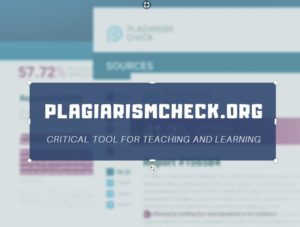 One of the biggest problems facing digital natives as they grow into adults is understanding how to maneuver the vastness of the Internet ethically, safely, and to serve their needs. It sounds simple–log on, search, enjoy–but let’s equate this to a shopping mall. You enter the wide, inviting front doors, find the store with the product you need, and then must pay for it. If you don’t have money, you can’t get the product. Even if you could sneak it into your purse, you don’t because that’s stealing (and besides, someone might see you).
One of the biggest problems facing digital natives as they grow into adults is understanding how to maneuver the vastness of the Internet ethically, safely, and to serve their needs. It sounds simple–log on, search, enjoy–but let’s equate this to a shopping mall. You enter the wide, inviting front doors, find the store with the product you need, and then must pay for it. If you don’t have money, you can’t get the product. Even if you could sneak it into your purse, you don’t because that’s stealing (and besides, someone might see you).
The concept of ‘buy’ and ‘money’ are often blurry on the Internet but the idea is the same: If you can’t follow the website’s rules to acquire the online product, you can’t have it. If you take it, that’s plagiarism and–like stealing from a store–carries drastic penalties.
Me, I don’t want to cheat anyone so when I acquire resources from the Internet, I want to do it legally. That’s why plagiarism checkers are important to me. There are many to choose from but one I recently discovered is PlagairismCheck.org. It requires no installation, is quick and intuitive to use, and covers everything I need at a fair price.
What is PlagiarismCheck.org
PlagiarismCheck.org is an online plagiarism checker that uses a sophisticated algorithm to check content for different types of plagiarism. It can operate as a stand-alone web-based tool or be integrated into an LMS like Google Classroom or Moodle. When you set up an account, you tell it whether you want to access it as a teacher, a student, or an individual owner. Each provides different tools. For example, teachers can collect assignments through PlagiarismCheck.org and track student submittals while checking for the authenticity of assignments. Once you have your account set up, you get one page for free, to see how PlagiarismCheck.org works. From there, you purchase packages depending upon how many pages you’d like to check. If you are purchasing a school subscription with roles like students, teacher and owner, you won’t need to purchase packages as individuals. You’ll pick from two subscription models:
- per page. School purchases pages for all its members, and members are using pages to run checks.
- per user. School purchases licenses for users, giving users unlimited access to the software (no page restrictions apply).
The goal of PlagiarismCheck.org is not to catch students plagiarizing (though it does) but to help them succeed in their academic ventures. It’s a subtle difference in interpretation but a big difference in attitude and results.
One more note: PlagiarismCheck.org is an excellent tool not only for students but for writers, entrepreneurial businesses, and teacher-authors. For the purposes of this post, I’ll concentrate on teacher-student uses.
Share this:
Plagiarism: What it is and how to identify it
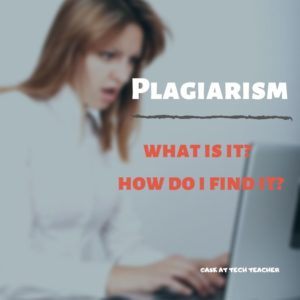 Man is a thinking creature. We like evaluating ideas and sharing thoughts. That’s a good thing. The more we collaborate, the smarter we all become.
Man is a thinking creature. We like evaluating ideas and sharing thoughts. That’s a good thing. The more we collaborate, the smarter we all become.
Implicit in this is that we don’t claim someone else’s ideas as our own. In fact, it’s illegal to do this. Read through this rephrasing of American copyright law:
“The law states that works of art created in the US after January 1, 1978, are automatically protected by copyright once they are fixed in a tangible medium (like the Internet). BUT a single copy may be used for scholarly research (even if that’s a 2nd grade life cycle report) or in teaching or preparation to teach a class.” –Jacqui Murray, Ask a Tech Teacher
When we claim someone else’s work as our own, be it text, artwork, movies, music, or any other form of media, it’s called plagiarism:
“[Plagiarism is the] wrongful appropriation of another author’s language, thoughts, ideas, or expressions”
The rules and laws surrounding plagiarism aren’t nearly as well-known as those that deal with, say, driving a car or illegally crossing a street. The Josephson Institute Center for Youth Ethics surveyed 43,000 high school students and found that:
- 59% of high school students admitted cheating on a test during the last year. 34% self-reported doing it more than twice.
- One out of three high school students admitted that they used the Internet to plagiarize an assignment.
One note: Laws addressing plagiarizing differ throughout the world. This article deals with commonly-accepted international guidelines and specific rules aligned with the laws of the United States.
Share this:
An Easy, Reliable Way to Check for Plagiarism
 The unauthorized use of another’s creative content has always been a problem but with the growth of the Internet, it’s become epidemic. The prevailing wisdom seems to be:
The unauthorized use of another’s creative content has always been a problem but with the growth of the Internet, it’s become epidemic. The prevailing wisdom seems to be:If it’s online it’s free
This, of course, isn’t true but the rules and laws surrounding plagiarism and copyrights aren’t nearly as well-known as those that deal with, say, driving a car or crossing a street. The Josephson Institute Center for Youth Ethics surveyed 43,000 high school students and found that:
- 59% of high school students admitted cheating on a test during the last year. 34% self-reported doing it more than twice.
- One out of three high school students admitted that they used the Internet to plagiarize an assignment.
Dissuading students from improper use of online materials is a massive effort that few are willing to undertake. Teachers are at ground zero and start with three basic rules:
Share this:
Tech Tip #123: Quick Search for Plagiarized Images
As a working technology teacher, I get hundreds of questions from parents about their home computers, how to do stuff, how to solve problems. Each Tuesday, I’ll share one of those with you. They’re always brief and always focused. Enjoy!
Q: I’m teaching a class on internet forensics–to drive home the point that the internet is a scary place for the uninformed. I know people who use facial recognition tools to search FB, Instagram and those sorts of picture curatators. Most of the programs I’ve found are expensive and complicated. Is there an easy one to share with my students:
There sure is–Google’s Image Search. Go to:
Upload an image you want to search for (or drag-drop it into the field), like this one:
Google will find all the places it appears:



